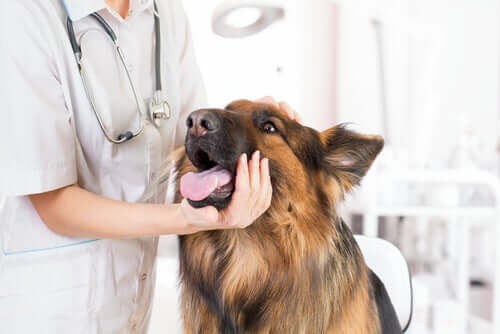All About Dry Eye Syndrome in Dogs

Dry eye syndrome in dogs is a common ophthalmological illness that can affect man’s best friend. Therefore, it’s important to be aware of this illness and to know how to recognize the symptoms. This is the best way to prevent blindness and severe damage to an animal’s vision.
What is dry eye syndrome?
“Dry eye” and “dry eye syndrome” are popular names for Keratoconjunctivitis sicca (KCS), an ophthalmological illness. It consists of a chronic inflammation that affects a dog’s tear glands, conjunctiva, and cornea.
This inflammatory process causes alterations in the quantity and quality of tears a dog’s body produces. This can produce a lack of tears, low-quality tear flow and/or an imbalance in the distribution of tears in the ocular structure.
The most direct consequence is a lack of protective moisture in the eye. Therefore, as the illness advances, it makes the ocular structure more and more vulnerable. And, if the issue isn’t treated in time, it can lead to blindness and irreversible damage to a dog’s vision.

Understanding a dog’s eyes and visual mechanisms
The visible part of the eye is just a small part of what makes up the optical structure. So, in the posterior and non-visible portion of the eye, we find the cornea, crystalline, retina, nerves, and optical disc.
Any type of alteration to these structures has negative consequences for a canine’s ability to see.
There are also more complex ophthalmological disorders that can assail a wide variety of animals. Glaucoma and Keratoconjunctivitis sicca are the illnesses that most commonly affect our pets.
How to identify dry eye syndrome in dogs
It’s very important to be on the alert for any small changes in your dog’s behavior and appearance in order to identify dry eye syndrome. Early diagnosis is key when it comes to having better options for curing the disease and keeping it from worsening.
The main symptoms of dry eye in dogs are the following:
- Discomfort, burning, and/or itching around the eye
- Reddening of the eye
- A secretion of mucus with or without pus from one or both eyes
- Frequent blinking
- Impulsive and permanent scratching of the area around the eye
- Swelling of the cornea
In the most serious cases, the swelling can produce excessive tearing (watering of the eyes).
What are the causes of dry eye syndrome?
There are multiple factors that can produce and/or exacerbate the inflammatory process of dry eye syndrome in dogs.
Aging
The passing of time causes a natural decrease in moisture in a dog’s eyes. Therefore, older dogs tend to be at greater risk of suffering from dry eye syndrome.
Genetic and/or anatomical predisposition
The Yorkshire and the Pug both possess genetic alterations that make it common for them to develop dry eye syndrome.
Also, brachiocephalic dog breeds or those with short noses are more prone to experiencing poor distribution of tears. For example, the French and the English Bulldog. Therefore, this characteristic can lead to early keratoconjunctivitis sicca.
While it’s not completely proven, there seems to be a certain predisposition for dry eye syndrome among a number of other breeds as well. These include the Teckel, Boston Terrier, Cocker Spaniel, Lhasa Apso, Pekinese, Shih Tzu, Cavalier King Charles Spaniel, Samoyed, and Schnauzer.
Systemic, autoimmune, and metabolic illnesses
Systemic, autoimmune, and metabolic illnesses can also be a cause of dry eye syndrome in dogs. This is true for lupus, diabetes, hypothyroidism, distemper, as well as several others.
Viral infections
Exposure to certain viruses can also cause man’s best friend to experience chronic inflammation of the eyes. Distemper is a serious illness that can be deadly and is also related to dry eye syndrome in dogs.
Intoxications
Exposure to toxic substances is a risk factor when it comes to the development of neurological, ophthalmological and nervous illnesses.

Are there treatment options available for dry eye syndrome?
The treatment of this ocular condition can vary according to the primary cause. As we’ve explained, the swelling process is often a secondary symptom of another disease. When this is the case, then it’s important to treat the source of the problem.
The common curative methods consist of applying eye drops or artificial tears. At the same time, veterinarians may prescribe the administration of pharmaceuticals that stimulate the production of tears.
In the most serious cases of this illness, surgical intervention is the best option. Here, the objective is the transplant of the salivary ducts or glands in order to correct the poor lubrication of the eye.
How to prevent dry eye syndrome in dogs
It’s impossible to prevent genetic predispositions and the aging process. But what we can do is prevent risk factors and delay the appearance of this illness.
First and foremost, it’s fundamental that dog owners provide their pets with proper nutrition. What’s more, daily exercise and keeping your dog’s vaccines and worming up to date are key factors in prevention. All of these practices will strengthen your dog’s immune system and prevent the development of a variety of inflammatory and infectious processes.
A more specific measure that you can take to prevent dry eye syndrome in dogs is to avoid situations that can dry their eyes. This means not exposing your pet to excess solar radiation, natural or artificial wind, air conditioning, and heating.
Source of main image: Javier Enjuto
